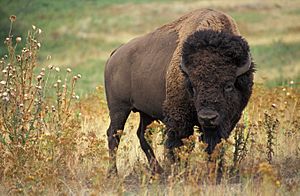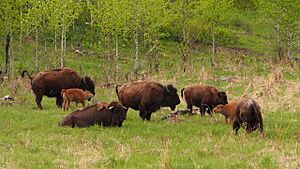Plains bison facts for kids
Quick facts for kids Plains bison |
|
|---|---|
 |
|
| Conservation status | |
| Scientific classification |
|
| Kingdom: | Animalia |
| Phylum: | Chordata |
| Class: | Mammalia |
| Order: | Artiodactyla |
| Family: | Bovidae |
| Subfamily: | Bovinae |
| Genus: | Bison |
| Species: | |
| Subspecies: |
B. b. bison
|
| Trinomial name | |
| Bison bison bison (Linnaeus, 1758)
|
|
| Synonyms | |
|
Bison bison montanae |
|
The Plains bison (Bison bison bison) is a type of American bison. It is one of two main kinds, or subspecies, of American bison. The other is the wood bison.
Plains bison once roamed across huge areas of North America. Today, wild groups live in places like Yellowstone National Park. About 4,800 bison live there. Smaller groups have also been brought back to many parts of the United States and Canada.
Contents
A Close Call: How Bison Were Saved
At one time, more than 25 million American bison lived across the United States and Canada. They were everywhere! But by the late 1880s, their numbers dropped sharply. There were fewer than 600 bison left in the United States.
Most of these few bison were on private ranches. The last wild group had fewer than 30 animals. They lived in the area that later became Yellowstone National Park.
Why Bison Almost Disappeared
Many farmers and ranchers saw bison as a problem. But some people worried about losing this important North American animal. People started to protect them. Some landowners and zoos helped save them.
Some people saved bison to raise them for meat or hunting. Others, like the American Bison Society, wanted to save the species. They hoped to bring bison back to their natural homes.
Bringing Bison Back Home
Since then, Plains bison have been brought back to many places. Five main groups of American bison helped save them from disappearing.
In 1928, bison were brought to Delta Junction, Alaska. This group grew well. By the late 1900s, there were hundreds of them. Bison from this group also went to other places in Alaska.
Bison usually like grasslands and plains. But they can live in many different places. They live in deserts, like the Henry Mountains bison herd. They also live in forests, like the Yellowstone Park bison herd. All these bison are the same subspecies, Bison bison bison.
Today, over 500,000 bison live in the United States and Canada. Most of these are on private ranches. Some of them have a tiny bit of cattle DNA mixed in.
Important Wild Bison Herds
Some large wild bison herds do not seem to have any cattle DNA. These include the herds in Yellowstone Park and the Henry Mountains. Other important herds are in Custer State Park and Wind Cave National Park. There are also herds in Wood Buffalo National Park in Canada.
In 1956, Plains bison were moved to Theodore Roosevelt National Park. This helped grow the bison population there.
In 1969, bison from Elk Island National Park went to Prince Albert National Park in Saskatchewan. This created the Sturgeon River bison herd. About 300 animals now roam freely there.
In 2006, bison from Elk Island National Park in Alberta were released into Grasslands National Park in Saskatchewan. This was the first time wild bison walked the shortgrass prairies of Canada in a long time. Parks Canada says that all these wild bison came from just eight animals. These eight survived the time when bison almost vanished.
A herd of about 650 bison lives at the Wichita Mountains Wildlife Refuge in Oklahoma. This herd started in 1907. Fifteen bison were sent there from the New York Zoological Park (now the Bronx Zoo). Bison had disappeared from Oklahoma because of too much hunting. Some bison from this group have been moved to other places, like Paynes Prairie in Florida.

Only one southern Plains bison herd was started in Texas. A small group of these bison was saved in 1876. "Molly" Goodnight asked her husband, Charles Goodnight, to save some of the last bison. They were hiding in the Texas Panhandle. By saving these few bison, she started a herd near the Palo Duro Canyon. This herd grew to 250 bison by 1933. Bison from this herd were sent to Yellowstone National Park in 1902. They also went to large zoos and ranches. About 80 bison from this group now live in the Caprock Canyons State Park in Texas.
Ted Turner owns the largest private bison herd in America. It is at his Vermejo Park Ranch in New Mexico. The Boy Scouts of America also have a private bison herd at Philmont Scout Ranch.
In 2013, bison from Yellowstone National Park were brought to the Fort Belknap Indian Reservation.
In 2017, Plains bison were successfully brought back to Banff National Park in Alberta. The bison were watched in a fenced area until 2018. After that, they were allowed to roam free. Parks Canada will continue to watch them until 2022.
How People Use Bison
Native American plains tribes traditionally used every part of the bison. They used the meat, fat, and organs for food. But they also made many tools and items from bison.
Tools and Everyday Items
- They made arrow points, needles, and hoes from bones.
- Spoons were made from horns.
- Bow strings and thread came from sinew (tough tissue).
- Waterproof containers were made from the bladder.
- Paint brushes were made from the tail and bones.
- Cooking oil came from tallow (fat).
Bison skulls were sometimes used in ceremonies as altars. Rawhide (untanned hide) was used for bags, shield covers, and moccasin soles. Hides with fur were used for blankets, wraps, and warm clothes.
Clothing and Art
Tanned hides were used for clothing, moccasins, and tipi covers. The best hides were tanned with the animal's brains and then smoked. These hides were also used for winter counts (calendars) and artwork.
See also
 In Spanish: Bisonte americano de llanura para niños
In Spanish: Bisonte americano de llanura para niños



